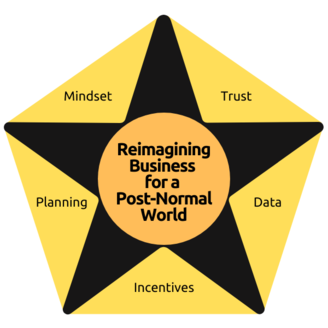Welcome to the post-normal world
Comforting as it may seem to talk of a ‘new normal’, as the events the past month have once again shown, we are still some way away from a time we can describe as being any kind of normal.
For businesses, that will remain true for at least another 2-3 years, as we grapple with the volatile environment that the ‘20s have ushered in: the most significant disruption most of us can remember. Not ‘new normal’, then, but post-normal.
So how do we reimagine our businesses to thrive in a post-normal world?
I believe that there is a real opportunity to reshape our organisations. We face today some big choices about the businesses we want to run – not to mention the businesses we want to buy from and work for.
I’ve created a five-point framework that sets out how we can achieve this. In this article, I’m going to focus on the first of these five points:
Mindset
There are some foundational choices we need to make. What mindset are we going to adopt?
Denial is tempting, as ever in volatility. It can even be a successful strategy, in a few circumstances. I strongly argue, however, that this is unlikely to be one of them. To indulge in the seductive luxury of thinking we’re in a new normal is to engage in denial. It’s comforting to think we still live in a predictable world. It gives us permission to carry on as if this weren’t happening.
But if we are to overcome the challenges of the post-normal world, we need to embrace an open mind(set) – a mindset that explores all the possible scenarios that we could see unfold in the short- medium- and long- term. There will be several credible scenarios to consider… certainly more than just ‘best case’, ‘worst case’, ‘somewhere in the middle’.
Once we are equipped with our scenarios, the next step is to create a range of strategies to respond to each of them. A scenario playbook, if you will. Some of the scenarios we prepare for will present problems to overcome, others will show opportunities we can grasp.
It’s likely that you won’t execute every plan in your playbook – and that’s okay. But you will have your response worked out and ready to execute if and when the data shows you that need to. After all, great businesses are those that:
- Make bold promises – and keep them
- Identify problems early – and fix them
- Identify opportunities quickly – and act on them
If your business aspires to greatness, your scenario playbook becomes indispensable. The final mindset choice is between the industrial mindset that characterised the past couple of centuries and the digital mindset that draws on the lessons of agile management and the lean movement.
The Industrial mindset can be characterised by a command and control approach, underpinned by an ethos of continuous, often incremental improvement. Predictability and uniformity are praiseworthy attributes.
Digital, in contrast, is a much more agile mindset, one that puts a high value on ideas like ‘failing fast’ and ‘pivoting’.
So the easy answer might be, in uncertain times, to pick the digital approach. Given that more and more of our lives this year have moved online, isn’t that the logical response?
There is another option.
Systems leadership is based on the discipline of systems thinking. It centres itself at the intersection of the digital and physical world, recognising that the customer doesn’t live in exclusively in one of these domains.
Systems leaders have learnt to become masters of both digital and real-world, able to tackle problems from a holistic perspective. Doing so opens options that would have been hidden from those siloed in one world or the other.
Think about Google, perhaps the ultimate digital business at first glance. But very early in their existence, Google’s approach to organising the world’s knowledge started to stray beyond the confines of 1s and 0s. For example, they started to build their own data centres – think of them as the physical manifestations of their digital empire. Meanwhile, as customers of Google, we now rely on them to navigate our way around the physical world, to communicate on mobile devices powered by Google’s operating system (some of which they actually made), or help us to located the goods and services we receive in 3D.
On the flip side, Apple have become the world’s first two trillion-dollar company in part by extending their revenue model beyond making physical product. This year the digital services side of their business (Apple Pay, the App store, Apple Music etc) has raced past 20% of their total (massive) turnover.
Systems thinking combines the skillsets of the digital and physical world, together. The systems leader puts the value to the consumer at the heart and recognises that the way we’ll best offer that value will combine both digital and physical thinking. With the company’s value the customer at the centre, the systems leader can make decisions that consider both physical and digital constraints and opportunities, that combine their view of human and technical resources, partners and the markets in which they operate.
At a time when, as businesses, we need to re-examine what the best way to create value from what we have, it seems clear that systems leadership mindset is the way to go.
Critically, systems thinking advocates running toward disruption, not just sit back and hope it goes away.


Contact us
Call us on 07930 356305 or email HQ@russam.co.uk








